Breaking barriers, building bridges: the collaborative effort to reach every child in Nigeria
Immunization remains a mainstay in safeguarding children's health worldwide but achieving universal vaccination coverage has been a significant global challenge.
- 12 September 2023
- 6 min read
- by WHO

Immunization remains a mainstay in safeguarding children's health worldwide but achieving universal vaccination coverage has been a significant global challenge. In lower and middle-income countries, more than 12.4 million children received no vaccines in 2020. These vulnerable children, known as "zero-dose children", account for a substantial portion of preventable deaths in children. Nigeria faces a particularly alarming situation among these countries, with over 2.2 million estimated zero-dose children in 20211. To address this pressing issue, the signatory agencies of the Global Action Plan for Healthy Lives and Well-being for All (SDG3 GAP) are collaborating with the Nigerian government to reach every child with immunization services. Through their joint efforts, SDG3 GAP partners embrace a collaborative approach as the most effective path toward achieving this critical goal.
Collaborating to locate zero-dose children and missed communities

Credit: WHO/Eromosele
Reaching zero-dose children requires locating and engaging the communities they belong to. Since such communities often include remote rural, urban poor, or conflict affected areas facing various forms of deprivation, cross sectoral collaboration is needed to identify and reach them. Starting in 2020, SDG3 GAP partners and the Nigerian government collaborated to create a data system to identify zero-dose communities. Led by the National Primary Health Care Development Agency (NPHCDA) and supported by UNICEF and WHO, this effort combined data from various sources, such as immunization records, health facilities, surveys, and local community data at the sub-national level.
Joint workshops and meetings with stakeholders were organized, resulting in a detailed analysis pinpointing 100 local government areas (LGAs) in 18 states that account for 1.5 million of Nigeria's 2.2 million zero-dose children. This analysis informed the design of zero-dose priority actions within the National Strategy for Immunization and PHC System Strengthening (NSIPSS), providing a comprehensive framework for improving immunization coverage. It also provided the basis of collaborative efforts and plans between partners to reach these communities.
NPHCDA and partners including WHO and UNICEF developed an Immunization Recovery Plan 2022-2025 that incorporated a Big Catchup Plan specifically targeting zero-dose children. Through the GAVI-HSS project, GAVI collaborated directly with eight priority states, addressing low immunization coverage and a high burden of zero-dose children with a USD 50 million PHC and immunization grant. The World Bank partnered with 16 priority states through the Immunization Plus and Malaria Progress by Accelerating Coverage and Transforming Services (IMPACT) Project, focusing on strengthening vaccine supply, cold chain equipment, and monitoring systems to reduce under-five mortality rates. Additionally, funding channels and technical assistance from the Global Fund, WHO, and UNICEF supported 17 states in reaching identified zero-dose local government areas.
Extending the reach for zero-dose children

Credit: WHO
In their pursuit to reach zero-dose children across Nigeria, SDG3 GAP partners are leveraging their previous investments in polio eradication and COVID-19 response to expand immunization coverage nationwide. These investments have not only established valuable infrastructure and skilled human resources but also fostered strong community networks with trusted relationships with local leaders. Leveraging these networks, partners are now facilitating the delivery of immunization services to zero-dose children across the entire country.
Supported by UNICEF, GAVI, and WHO, these networks are being transformed into formal Community Health Influencers, Promoters, and Services (CHIPS) as part of the Nigerian government's community engagement strategy. The CHIPS program, initiated in 2018, promotes local ownership and engagement, employing community-led case-finding strategies to identify and immunize zero-dose children within the national community engagement framework. Through joint efforts, SDG3 GAP partners, National Primary Healthcare Development Agency (NPHCDA) and other stakeholders have developed national implementation guidelines for the CHIPS strategy, ensuring effective local participation and progress in reaching every child with life-saving vaccines.
Have you read?
As of January 2023, integration of routine immunization in COVID-19 vaccination efforts have seen more than 4 million eligible children immunized since March 2021, out of which over 700,000 received Penta-3 vaccination. NPHCDA continues to engage with the 100 priority zero dose LGAs to design and implement customized and effective strategies to reach zero dose children in settings unique to each community/LGA.
Building sustainable financing for immunization and PHC

Credit: WHO/Ogbeide E.
SDG3 GAP partners and the Government of Nigeria are committed to sustainable financing and strong primary healthcare as key accelerators of continued progress in reaching every child in Nigeria. The Government of Nigeria has shown strong political commitment and leadership in these areas, leading to active engagement, and coordinated approaches with SDG3 GAP signatories and other partners to drive important reforms. Recent reforms such as the National Health Insurance Authority Bill and the Basic Healthcare Provision Fund are being implemented nationwide to ensure financial protection and sustainable financing for primary healthcare services, including immunization. An accountability framework with state governments is also in place to secure incremental Government funding for immunization and primary healthcare, with the goal of achieving full state government funding by 2028. The presidential health reform committee has also prioritized PHC revitalization to address gaps in immunization coverage.
Under the leadership of the UN Resident Coordinator, coordination and alignment with country-led efforts have been enhanced within the UN system, as seen in the Nigeria - UN Sustainable Development Cooperation Framework (UNSDCF) 2023-2027, and with other partners through ongoing multi-partner health financing interventions. Through these collaborative approaches the Nigerian government, SDG3 GAP partners, and other stakeholders are establishing sustainable funding mechanisms to enhance primary healthcare and effectively close immunization gaps in the country.
To ensure that SDG3 GAP support continues to be aligned with country-led priorities and approaches, SDG3 GAP partners have established a monitoring framework through which National governments provide feedback regarding ongoing collaborative work, including strategies and opportunities for better collaboration. Feedback from Nigeria in 2022 highlighted improved collaboration, alignment with national plans and budget priorities, utilisation of national monitoring systems, and effective coordination mechanisms resulting from SDG3 GAP support. While significant progress has been made, the government feedback highlighted areas requiring further action, including carrying forward good practices such as the country compact between development partners, increased resource commitment, and the co-creation of partner implementation plans with local stakeholders, particularly at the sub-national level.
What is the SDG3 GAP?
The Global Action Plan for Healthy Lives and Wellbeing for All (SDG3 GAP) is a set of commitments by 13 agencies that play significant roles in health, development, and humanitarian responses to help countries accelerate progress on the health-related SDG targets. The added value of the SDG3 GAP lies in strengthening collaboration across the agencies to take joint action and provide more coordinated support aligned to country owned and led national plans and strategies.
1. Multi Indicator Cluster Survey/ National Immunization Coverage Survey (MICS/NICS) report, Nigeria, 2021.
Website
This article was originally published by the World Health Organization on 30 August 2023.








